
views
X
Trustworthy Source
Cleveland Clinic
Educational website from one of the world's leading hospitals
Go to source
If you want to reap all the tasty benefits of this superfood, the great news is that it’s easy to grow at home. In this guide, we’ll show you how to get your spirulina colony started, care for it to keep it growing healthy, and harvest it to enjoy it on its own or in delicious meals.
- To grow your own spirulina, you'll need a clear aquarium tank, jug, or other container that lets sunlight in. The bigger the container, the more spirulina you can grow.
- Add a live spirulina culture starter to the container with water and fertilizer and watch your spirulina grow!
- In 3-6 weeks, your spirulina will be ready for harvest.
Setting Up the Spirulina’s Environment

Set a clear tank in a warm, bright place out of direct light. Spirulina algae grow in water and need lots of bright, indirect light to thrive. So, get out a clear aquarium tank, jug, or another transparent vessel for the spirulina to call home. Then, set your tank in a sunny spot, like a window, that’s out of direct sunlight. The size of the tank you choose is completely up to you. Larger tanks generally produce more spirulina than smaller ones. If you don’t have lots of sunny, indirect light, set grow lights over your tank. If you have a lot of intense, direct light, place a shade net over the tank.
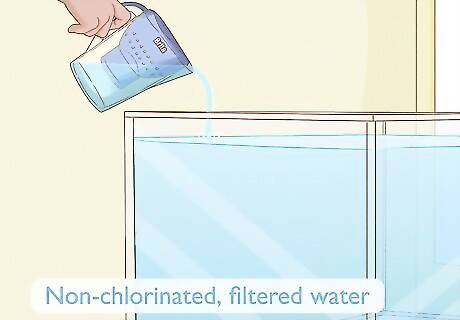
Fill the tank with non-chlorinated, filtered water. Regular tap water is full of chemicals and minerals, like chlorine, that spirulina can’t tolerate. To filter regular tap water, simply pour it through a standard carbon filter, like a Brita or Pur filter. Or, dechlorinate your water with an aquarium water conditioner. Alternatively, use bottled spring water if you don’t want to filter tap water. Do not use distilled water or water that’s gone through a reverse osmosis system, as the water won’t have enough nutrients for the spirulina to feed on.

Mix spirulina fertilizer into the water. Spirulina doesn’t just grow in water—it needs a mixture of specific nutrients and minerals to feed on and multiply. Find a premixed spirulina fertilizer online or at your local health food and organic supply stores. Just stir in enough spirulina fertilizer “food” for the amount of water in your tank according to the package’s directions.
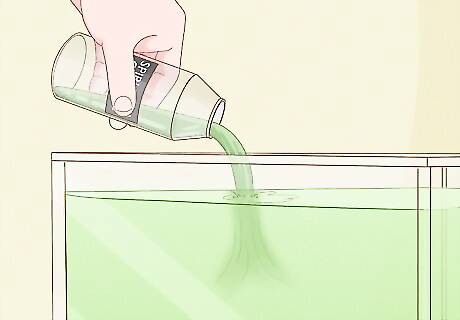
Add a live spirulina culture starter into the tank. To get your own spirulina colony growing, you need a bit of live spirulina culture. Visit your local health food or organic supplies shop for spirulina cultures, or look for them online. Then, follow the instructions that come with your spirulina starter to add the right amount for the amount of growing medium (i.e. water and fertilizer) in your tank. In general, you pour ½ to ¾ of the spirulina culture into your tank. Some spirulina starters come with premixed fertilizer to get started.
Caring for the Spirulina
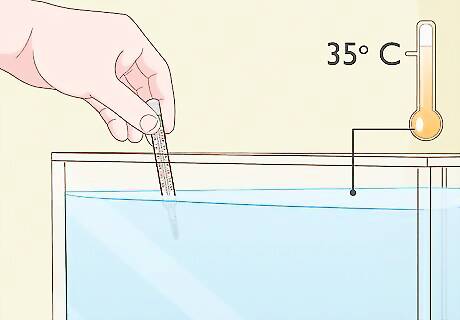
Maintain the water temperature at around 95° F (35° C). Spirulina thrives and grows the quickest in warm temperatures around 95 to 98° F (35-37° C). Any temperature above 100° F (38° C) can cause the spirulina to die, while growth typically slows down below 60° F (16° C). Just insert an aquarium thermometer into the tank to make sure the water stays at an optimal temperature. If your tank isn’t staying warm enough from the light, add an aquarium heater to the tank. These are found online and at aquarium supply or pet stores. Wash your thermometer and aquarium heater with soap and water before you insert them into the tank. If you’re leaving your spirulina for an extended period of time, lower the temperature and move it to a more shady location to slow down its growth.
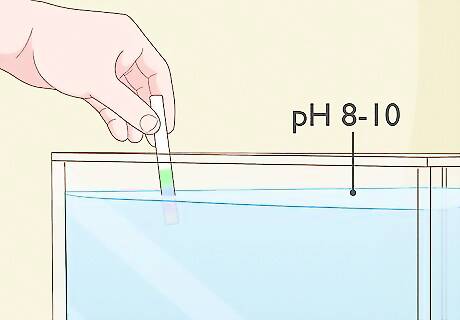
Use pH strips to ensure the water stays between 8 to 10 pH. Spirulina needs a very basic, rather than acidic, growing medium to stay happy and healthy. Every few days, check the pH of the water in the tank using pH strips. When you first add the spirulina, the pH should be around 8 or 8.5. As the spirulina grows, the pH rises to 10. If the spirulina’s water is below 8 pH, sprinkle in some baking soda to raise the pH. If the spirulina’s water gets above 11 pH, it’s time to mix up a new batch of growing medium; this usually happens after 4 to 6 months. To renew the growing medium, add filtered water and fertilizer into a new tank. Then, harvest the spirulina (explained below) and add it to the new tank.
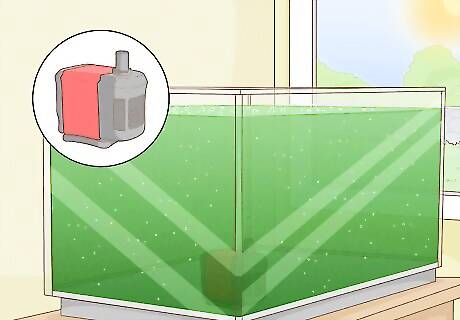
Stir and agitate the spirulina at least 2 times per week. Your spirulina needs oxygen to grow and thrive. To get air into the water and ensure all of the spirulina gets enough sun, simply stir the medium at least twice each week. Or, place an aquarium air pump into the water. This is a hands-off way to ensure a steady supply of oxygen gets to the spirulina.

Adjust the lighting if the spirulina looks yellow or olive green. Healthy spirulina algae is a dark blue-green. If it’s getting too much light, the spirulina might start dying and appear yellowish or olive green. Just move the spirulina tank to a more shady location, or add a shade net over the tank.
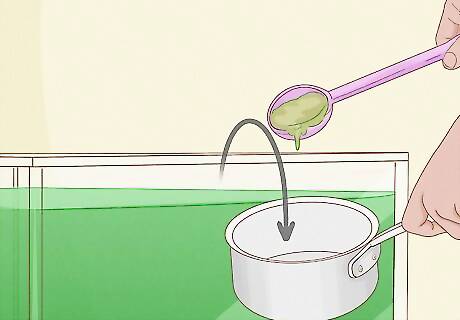
Clean the tank and remove any white or yellow spirulina clumps. Every few days, use a clean, damp cloth to wipe down the sides of your tank and its cover. Then, look for any spirulina clumps that are transparent, white, or yellowish—these spirulina clumps are unhealthy and unsafe to eat. Simply scoop them out of your tank with a spoon or spatula and throw them away.
Harvesting the Spirulina
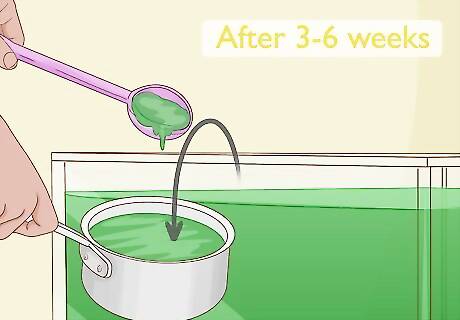
Scoop out the spirulina when the pH stays at 10 for 24 hours. After about 3 to 6 weeks, your spirulina colony will be thick and look a very dark shade of blue-green. This means it’s ready to harvest, so just test the pH to ensure it’s at 10. If it’s still at a pH of 10 the next day, simply scoop some spirulina out with a clean spoon, cup, or bowl. If you’re consuming the spirulina fresh, 1 to 2 spoonfuls is typically enough. Do not harvest your spirulina if it’s at a pH below 10 or above 11, as it’s unsafe to eat. Simply adjust the nutrients to get the medium to 10. Do not harvest the spirulina if it smells funky or off and appears clear, white, or yellow. Healthy spirulina has a slightly seaweedy smell and is dark blue-green.
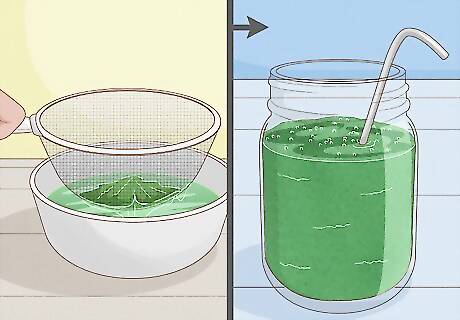
Filter and rinse your spirulina through a fine strainer cloth. Place the spirulina you took from your tank onto the fine cloth, hold it over a bowl, and gently squeeze out the excess water. You’ll be left with a thick green paste of spirulina. Then, rinse the spirulina off over your sink by running water through the cloth. Now you’re ready to enjoy your spirulina! Add the fresh spirulina to smoothies and dips, drizzle it on top of sandwiches, salads, and pastas, or eat it all by itself. Store any leftover spirulina in an airtight container in the fridge for 2 to 4 days. Pour the excess water you drained from the spirulina back into the tank, or dispose of it.
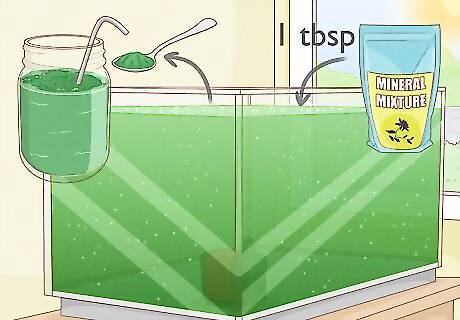
Replenish the spirulina colony's food. Each time you take some spirulina out of your tank, add back in an equal amount of fertilizer to ensure the colony keeps growing well. For instance, if you took out 1 tablespoon (15 ml) of spirulina, add about 1 tablespoon (15 ml) of the medium back in. Keep harvesting the same spirulina colony for about 6 months. Then, make a new growing medium, harvest the existing colony, and add it to the new tank.




















Comments
0 comment